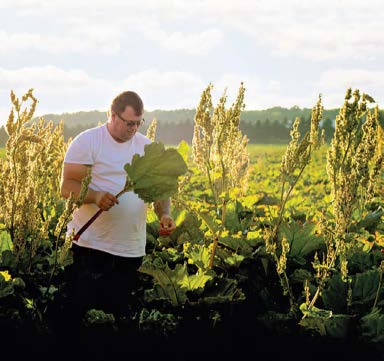

LENNOX FARM
MELANCTHON, ONTARIO
The French family plants a winter garden like no other. Following a British tradition dating back to 1817, they “force” rhubarb to produce stalks in a dark hothouse, resulting in a crop that is more tender and less tart than their outside plants (which produce some 200,000 pounds annually).
Their “forced” rhubarb grows in-doors on dirt floors, with the plants packed tightly together under three hothouses that total 10,000 square feet. In a good season, Lennox Farm will produce 10,000 to 12,000 pounds of winter rhubarb per hothouse.
That’s a lot of rhubarb—and a lot of noise. Winter rhubarb makes an audible sound when the buds break open. Not unlike champagne being uncorked, this “pop” (similar to a tongue click) is music to their ears.
The principles of growing winter rhubarb have changed little over the centuries, according to parents Bill and Diane French. The perennial is grown in 3 acres of outdoor fields for 2 years. Every November, workers at Lennox Farm lift the rhubarb crowns (each can weigh between 80 and 100 pounds!) and transplant them to the hothouses.
Once nestled into their dirt rows, the crowns rest for 50 days with no light and little or no heat; temperatures are 3°C or lower. After winter solstice, the heat is turned to 10°C to activate new growth.
By Valentine’s Day, the ruby-color stalks are ready for harvest, to become rhubarb crumble, strawberry– rhubarb pie, or preserves. Notably, these harbingers of spring require less sugar in cooking preparation than their field cousins.
Son Brian thinks that rhubarb might play a role in the burgeoning craft movement. Using a portable cider press, he makes juice from his outdoor rhubarb crop that local wineries and cideries find to be the perfect “pucker” ingredient.